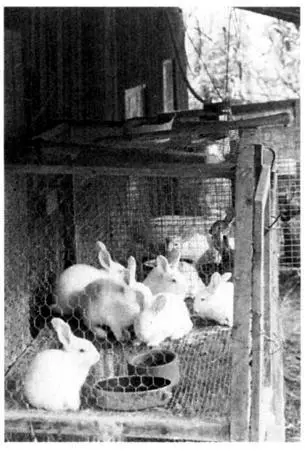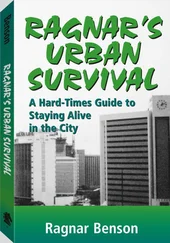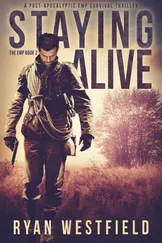Ragnar Benson - Ragnar's Urban Survival - A Hard-Times Guide to Staying Alive in the City
Здесь есть возможность читать онлайн «Ragnar Benson - Ragnar's Urban Survival - A Hard-Times Guide to Staying Alive in the City» весь текст электронной книги совершенно бесплатно (целиком полную версию без сокращений). В некоторых случаях можно слушать аудио, скачать через торрент в формате fb2 и присутствует краткое содержание. Год выпуска: 2009, ISBN: 2009, Жанр: Старинная литература, на английском языке. Описание произведения, (предисловие) а так же отзывы посетителей доступны на портале библиотеки ЛибКат.
- Название:Ragnar's Urban Survival: A Hard-Times Guide to Staying Alive in the City
- Автор:
- Жанр:
- Год:2009
- ISBN:1581600593
- Рейтинг книги:5 / 5. Голосов: 1
-
Избранное:Добавить в избранное
- Отзывы:
-
Ваша оценка:
- 100
- 1
- 2
- 3
- 4
- 5
Ragnar's Urban Survival: A Hard-Times Guide to Staying Alive in the City: краткое содержание, описание и аннотация
Предлагаем к чтению аннотацию, описание, краткое содержание или предисловие (зависит от того, что написал сам автор книги «Ragnar's Urban Survival: A Hard-Times Guide to Staying Alive in the City»). Если вы не нашли необходимую информацию о книге — напишите в комментариях, мы постараемся отыскать её.
Ragnar's Urban Survival: A Hard-Times Guide to Staying Alive in the City — читать онлайн бесплатно полную книгу (весь текст) целиком
Ниже представлен текст книги, разбитый по страницам. Система сохранения места последней прочитанной страницы, позволяет с удобством читать онлайн бесплатно книгу «Ragnar's Urban Survival: A Hard-Times Guide to Staying Alive in the City», без необходимости каждый раз заново искать на чём Вы остановились. Поставьте закладку, и сможете в любой момент перейти на страницу, на которой закончили чтение.
Интервал:
Закладка:
Chapter 1

Basic Survival Philosophy
"When it is extremely important that your pants stay up, use both a belt and suspenders, along with buttons on your shirttails," a Russian proverb says. This basic homily echoes the Golden Rule of Survival, known as the Rule of Threes.
The Pacific Northwest Nez Perce Indians probably deserve the most thanks for refining this rule into a genuinely workable survival plan. Most likely this plan became part of their culture in about 1730 with arrival of their first horses. The Nez Perce were the only tribe of North American Indians who learned to selectively breed their stock, leading to development of the famous Appaloosa warhorse.
The Nez Perce were unique in several other regards. They were the only tribe that did not routinely starve every winter. They had a lifesaving survival plan that soon became an integral part of their culture.
It was a model of simplicity, explaining in large part its great success. The Nez Perce discovered that for everything really, truly important to life, three separate and distinct methods of supply must be developed. As it evolved through the years, this Rule of Threes proved to be extremely wise. Obviously the Nez Perce applied this rule to their life in the country, but experi enced city survivors have found that it works equally well for them.

Nez Perce Indians lived well as a result of their survival philosophy.
The system's corollary proved equally profound. The Nez Perce foundespecially in the short run-it does not take very much in an absolute sense to stay alive. Elements of basic survival were simply seen as food, water, energy, shelter, and possibly articles of personal encouragement. In our culture these personal items might be art, music, or perhaps a Bible. One woman I know believes this should include a hot shower once a week. Because these items are so absolutely necessary, positive provision for their supply must be made. Twentieth-century experience suggests that we must include medications, clothing, and self-defense in this list. But we also now know passive defense systems- such as simply laying low and hiding-are often as effective as active ones.
First contact with Europeans for the Nez Perce came on September 20, 1805, when Lewis and Clark rode down out of the mountains into their remote area of what is now the state of Idaho. At that time the Nez Perce already owned six modern (for that era) rifles! These had been bartered from the Mandans and Hidatsa, who had bought them from French and British traders. Because their Appaloosa horses were so valuable, the Nez Perce were able to trade for equally valuable items such as rifles, powder, and balls. Another rule of survival comes into view
Even before firearms, the Nez Perce were able to survive using their Rule of Threes. Later on, having a few figurative trade dollars in their pouches allowed them to survive in much better style. It's still true today-those with their financial houses in order will survive better and more easily than those who are forced to live under more basic conditions. Those with money for guns and ammo, especially in cities, have a far better chance at survival.
While the basic Rule of Threes works in a day-to-day, practical sense in the city or country, it can also be deployed by those who are into recreational nuts-twigs-and-berries primitive survival. The rule gently draws all of us into a workable plan. People don't have to leave their current homes for mice-infested, drafty cabins in the hills in order to live.
FOOD
Employing the Rule of Threes, we know that when food is vital for you and your family's survival, you should develop at least three separate and distinct sources of supply. No one source can in any way be dependent on the other for its implementation. Each on its own should be capable of feeding you and your family during an emergency.
My father and his family in post-World War I Germany, for example, relied on the rabbits and pigeons they tended, the garden vegetables they raised, and wild edibles they found in the fields and city parks, as well as what they bartered for with surrounding farmers. They lived in the center of a large city.
In a more modern context, city dwellers can expect to rely on their domestic rabbits, their gardens, and scrounged edibles gathered from surrounding fields, parks, and rivers, as well as consumption of stocks of previously stored supplies as needed.
The other vital rule is the Rule of Survival Thermodynamics. This means that you must never put more energy into a survival activity than is taken out. Those who fail to heed this warning quickly become casualties.
This generally rules out sport hunting and fishing, but opportunistic shooting of critters for the pot in the course of other survival-related activities probably would not violate this precept. Keep in mind that in Indian cultures, most edible critters were caught in snares or deadfalls. Theories of fair chase and conservation did not enter the equation.

Survivors who have adequately prepared can expect to go to the food shelf to resupply.

Rabbits are ideal food animals for city survivors. They eat virtually anything green and are extremely prolific.
Gardening as a survival technique may also be impractical for many people who haven't gardened before in their specific area. However, survivors who are already practiced in their city-based gardening skills can probably see a net gain for their efforts.
Foraging in the city can also yield food, but it is difficult. Our early Indians learned to properly treat acorn meat (washing out the tannic acid), hunt wild bees, dig edible flower bulbs, and collect cattails and many other edible plants. Today, in the city or country, the only foraging technique that practically qualifies for most Americans involves gathering cattails. Other edibles are sparse, hard to recognize, of little food value, and generally unavailable in winter. As a practical matter, collecting nuts, berries, and twigs generally makes little survival sense.
But the good news for city dwellers is that cattails are every where. My old, old account regarding cattails with which many survivors are already familiar, involves the time I was riding in a taxi from National Airport at Washington, D.C., (now Ronald Reagan National Airport) into town with a skeptical newspaper reporter anxious to discredit all survivors. We passed acre upon acre of cattails growing wild along the Potomac River. My point about these being an excellent survival food that was commonly available in an emergency was instantly made.

Even when very large game is targeted, sport fishing and hunting is not usually viable for survivors.

Only opportunistic game shooting done while undertaking other jobs is a viable survival technique.
Читать дальшеИнтервал:
Закладка:
Похожие книги на «Ragnar's Urban Survival: A Hard-Times Guide to Staying Alive in the City»
Представляем Вашему вниманию похожие книги на «Ragnar's Urban Survival: A Hard-Times Guide to Staying Alive in the City» списком для выбора. Мы отобрали схожую по названию и смыслу литературу в надежде предоставить читателям больше вариантов отыскать новые, интересные, ещё непрочитанные произведения.
Обсуждение, отзывы о книге «Ragnar's Urban Survival: A Hard-Times Guide to Staying Alive in the City» и просто собственные мнения читателей. Оставьте ваши комментарии, напишите, что Вы думаете о произведении, его смысле или главных героях. Укажите что конкретно понравилось, а что нет, и почему Вы так считаете.











